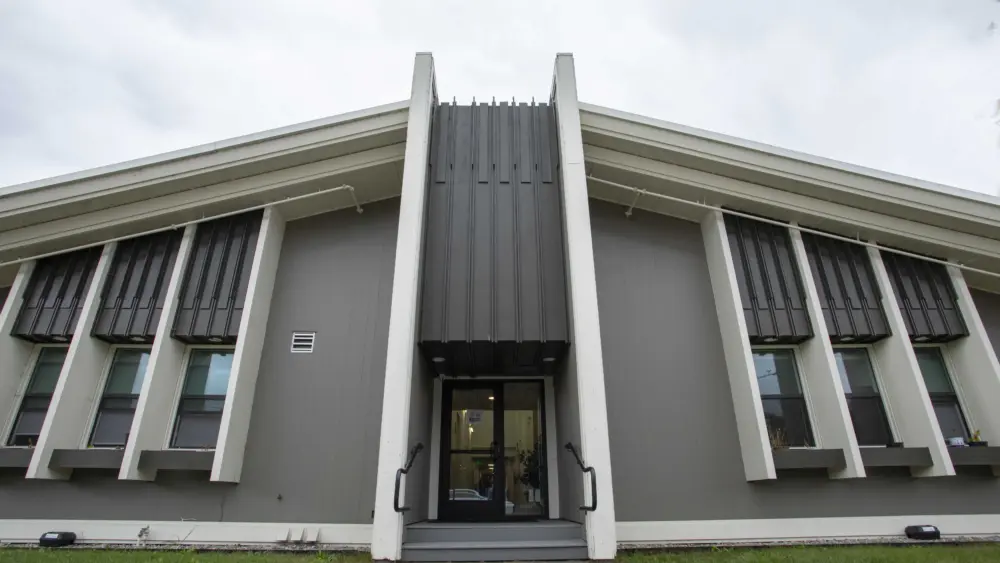Winemaking pioneer Davis Bynum looks back on a lifetime in the cellars.
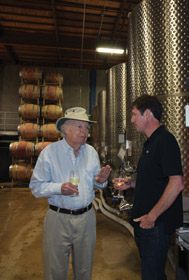 “It’s hard to believe that my next birthday will be my 90th,” says Davis Bynum, shaking his head. “I can think back about 50 years ago, wondering whether I’d even make it to the millennium or not. Now I begin to wonder if I’ll make it to the next millennium.”
“It’s hard to believe that my next birthday will be my 90th,” says Davis Bynum, shaking his head. “I can think back about 50 years ago, wondering whether I’d even make it to the millennium or not. Now I begin to wonder if I’ll make it to the next millennium.”The man whose name became synonymous with premium Pinot Noir and Chardonnay from Russian River Valley retired in 2007 after five decades of making wine, when he sold his label to the Klein family, owner of Rodney Strong Vineyards. Six months later, the Westside Road property Bynum had purchased in 1973 was acquired by another family, the Bakers. They renamed the property Thomas George Estates and made significant upgrades to the facilities.
Yet the Davis Bynum label continues to thrive, with three varietals––Pinot Noir, Chardonnay and Sauvignon Blanc––produced and bottled by Rodney Strong under the watchful eye of winemaker Greg Morthole.
Over a recent lunch of salmon cakes washed down with the crisp, citrusy Sauvignon Blanc that bears his name, Bynum reminisced about his adventures in the wine business and how his pioneering moxie brought fame and fortune to Sonoma County’s Westside Road, a place he once humorously dubbed “the Rodeo Drive of Pinot Noir.”
Home winemaking
Bynum grew up in Southern California, the son of a California historian who was also a wine writer and wine judge. “I learned about wine mainly through my father,” he says. “Then, when I became interested in making wine on my own, I learned by reading some university extension pamphlets.” But before entering the wine business full-time, Bynum attended Stanford University, served his country in World War II, earned a degree from UC Berkeley and became a reporter for the San Francisco Chronicle.
With their shared interest in wine, Bynum and his father frequently traveled to Northern California wineries, and Bynum’s first winery visit was to Charles Krug in St. Helena in 1950. A year later, he returned to Krug to see about buying some grapes—and came face-to-face with Robert Mondavi.
“I had a friend named Rogers whose family owned a wonderful old winery on Spring Mountain, and I was up there with him one day when we decided we wanted to make wine, even though we’d never done it,” recalls Bynum with a smile. “My friend said, ‘Let’s go see Bob Mondavi, I know him.’ So off we went to Charles Krug, and we arrived right as a truck pulled in with boxes of Petite Sirah grapes stacked five high.”
Robert Mondavi, who was running Krug at the time, walked out to the truck to record the delivery, and Bynum and his friend approached him about buying some of the grapes. “Mondavi told us to just a grab a box off the truck and he’d figure out the price,” says Bynum. “He was gone for 10 or 15 minutes and came back and said, ‘You owe me $1.80. Anything else?’ We said, ‘Yeah, how do you make wine?’ He said, ‘Talk to the guy in the truck, he’s a home winemaker.’”
While working for the Chronicle a few years later, Bynum visited Sebastiani Vineyards around harvest time to research an article. “I was having lunch with August Sebastiani and told him I was a home winemaker and that I’d run short of Cabernet to fill my barrels. He asked how much I needed, and I said about three more boxes. He told me to come back the next day when their Cabernet was being picked. So I took my kids along the next morning, but there were no grapes. August said, ‘Oh, my goodness, they’ve crushed them already. Let’s go get some.’ So August went with us into the vineyards and he helped us pick.”
Bynum recalls being impressed that large winery owners such as Mondavi and Sebastiani would take the time to personally him help out. “I can’t see that happening today, especially at the big places,” he says. “When I had my winery, I never would have had the time to do that—and I didn’t run a big winery.”
From Albany to St. Helena
Bynum made the leap beyond home winemaking in 1965, when he started a winery in a warehouse in Albany, not far from Berkeley, where he was living at the time. “I used to get bulk wine from the Pedroncellis and others back then,” he says. “The first Chardonnay I produced was from three or four barrels I bought from them, took back to Albany and bottled. But I’d buy grapes from all over.”
Inspectors with the Bureau of Alcohol, Tobacco and Firearms were a thorn in Bynum’s side in Albany, dropping by the winery at least twice per year to scrutinize his records. “They had a lot fewer wineries to inspect back then, and they could make it miserable for you,” he says, referring to the late 1960s.
“One day, this was probably 1968, I’d been at Pedroncelli to buy grapes and came back to Albany. I was driving past my winery and there was a car that I recognized as the BATF inspector’s. I knew I wasn’t ready for an inspection, so I just kept on going,” he laughs. “I came back about an hour later and he was gone. So I spent the rest of the day making sure my records were in order, because I knew he’d be back the next day.”
In 1971, Bynum purchased a 26-acre vineyard in St. Helena. “It was right on Highway 29, where Whitehall Lane Winery is now. I bought it for $120,000 from an interesting guy named Lou who’d been in the [Napa] valley forever. It didn’t have very distinguished grapes, just some Veltliner and some Petite Sirah, and about three acres of Charbono, which I really liked. Lou told me I should sell the Charbono as Barbera, because I’d get more money for it.”
When Bynum bought the St. Helena vineyard, he’d maxed out capacity at the Albany facility and had begun looking for a larger place. “I tried to rehabilitate an old winery in downtown St. Helena on Railroad Avenue,” he remembers. “I spent a lot of time and money working on it, but the St. Helena city council shot me down for a use permit because they said they didn’t want all those grape trucks going through town.”
Then he tried to get a permit for the vineyard itself, but was pressured to pay for an environmental impact report first. “I didn’t have enough money for an EIR; they’re expensive,” says Bynum. “So then there was a petition [for an EIR] going around, signed by something like 200 people. I swear, if I’d climbed the highest tree and looked around, I couldn’t see 200 people from our vineyard, so I just thought, ‘To hell with it.’ My friend Howard Allen said, ‘Why don’t you come over here [to Sonoma County]?’ Coincidentally, a realtor called me a month later and said he had a place on Westside Road we might be interested in. So we looked at it and bought it.”
Taking a chance on Pinot
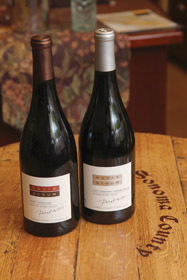 Bynum found the Westside Road neighborhood much friendlier than St. Helena, mostly by default. “Nobody wanted us to leave Westside Road, because there were no people there to complain,” he chuckles. “Davis Bynum was the first winery on Westside [in 1972], then I think Mill Creek was the next one, and then Hop Kiln. There was a building already on our property, even though it was in terrible shape. It had been the most modern hop kiln in the county, built just about the time the hops business went bottoms up. The main problem was the physical condition of the property and getting it ready to crush fresh grapes. Meeting payroll was also a challenge.”
Bynum found the Westside Road neighborhood much friendlier than St. Helena, mostly by default. “Nobody wanted us to leave Westside Road, because there were no people there to complain,” he chuckles. “Davis Bynum was the first winery on Westside [in 1972], then I think Mill Creek was the next one, and then Hop Kiln. There was a building already on our property, even though it was in terrible shape. It had been the most modern hop kiln in the county, built just about the time the hops business went bottoms up. The main problem was the physical condition of the property and getting it ready to crush fresh grapes. Meeting payroll was also a challenge.”In the early 1970s, Bynum says, not many winegrapes were being planted in west Sonoma County, because it was considered too cold. “There were some grapes, but usually the wrong kind for the climate, so they were high in acid. My friend Howie Allen was very interested in Pinot Noir and he thought the Russian River Valley climate was perfect for it. Joseph Swan planted Pinot in 1967, and Joe Rochioli did it in 1968. Joe planted a fair amount of it, but not a great amount.” Rochioli planted Chardonnay on the benchland and Pinot on the hills in the Allen Vineyard, according to Bynum.
“Joe was selling his Pinot to Martini & Prati Winery to go into its bulk wine––what they called ‘mixed black’ then––and he was getting $150 per ton for these beautiful Pinot grapes,” Bynum remembers. “I told him we’d pay more, $350 per ton the first year. All of a sudden, there were a lot of Pinot grapes available, but nobody was making it into wine. So for a while, I got all of Joe’s Pinot and more, and then Williams-Selyem Winery came along and offered him more money. By the time we sold the property [in 2007], we were paying $4,500 per ton for Russian River Pinot.” (Winemaker Morthole says today’s price is closer to $6,000.)
In 1973, with Pinot Noir grapes grown by Rochioli, Bynum became the first to bottle a single-vineyard Russian River Valley-designated wine. “And in those early days, we started getting a lot of people coming in and asking if we had a tasting room, because they wanted to buy the wine,” recalls Bynum. “I’d say, ‘Sure!’ So we rigged up a tasting room.”
Bynum and Morthole understand what the late winemaking innovator André Tchelistcheff meant when he remarked, “Any fool can make Cabernet, but only a fool would attempt to make Pinot Noir,” and “God made Cabernet Sauvignon, whereas the devil made Pinot Noir.”
“Yes, I think André was right,” says Bynum. “Cabernet has great big bunches that are easy to pick and you get a ton of grapes in no time at all. But Pinot grapes are smaller and in small bunches. Cabernet sort of makes itself––Pinot doesn’t.”
Morthole concurs: “I’d absolutely say you can neglect Cabernet in the vineyard a little, and even in the winery a little––but you don’t, of course. And if Cabernet gets a little too much air, it’s not a big deal. But Pinot, if it gets a little air, forget it.”
A quiet leader
Bynum had been interested in organic farming and gardening since he was a young man, so the vineyards at his winery were farmed that way from the beginning. “We didn’t have any idea that was unusual at the time,” he says. “Then my son, Hampton, went through the whole process of getting organic certification status, and we had to pay $1,200 per year for that. After three years of paying, I said, ‘What am I doing this for? I’ve always farmed this way.’ So we dropped the certification.”
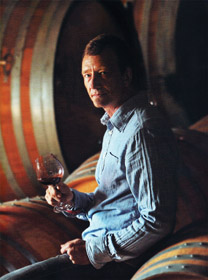 Guy Davis, owner and winemaker at Davis Family Vineyards in Healdsburg, considers Bynum to be one of the five most influential people in his own career and his deep connection to Pinot Noir. “Davis always had a passion for the sense of place in Russian River Valley, emphasizing the unique microclimates and how the fog comes up the river,” he says. “That’s all common knowledge now, but Davis knew early on that the best way to get the expression of Russian River Valley was by approaching the soil as the first living thing in the process, not just the vine. I still borrow thoughts from Davis today when I’m talking to sommeliers and viticulture students. He has always been a quiet leader, just by the example of how he conducts himself.”
Guy Davis, owner and winemaker at Davis Family Vineyards in Healdsburg, considers Bynum to be one of the five most influential people in his own career and his deep connection to Pinot Noir. “Davis always had a passion for the sense of place in Russian River Valley, emphasizing the unique microclimates and how the fog comes up the river,” he says. “That’s all common knowledge now, but Davis knew early on that the best way to get the expression of Russian River Valley was by approaching the soil as the first living thing in the process, not just the vine. I still borrow thoughts from Davis today when I’m talking to sommeliers and viticulture students. He has always been a quiet leader, just by the example of how he conducts himself.”At its peak, Davis Bynum Winery employed a staff of 12, along with seasonal part-timers. In the late 1980s, the winery was producing as many as 30,000 cases annually. By the time Bynum sold the brand seven years ago, production had decreased to between 12,000 and 14,000 cases.
Today, production is back up to around 23,000 cases, says Morthole, who was named winemaker for the Davis Bynum label in 2010. When they purchased the brand, the Kleins stated they’d focus on producing only Pinot Noir and Chardonnay, but Morthole lobbied to get Sauvignon Blanc added back into the Davis Bynum portfolio. “We now make about 10,000 cases of the Chardonnay, 10,000 cases of the Pinot Noir and about 1,500 cases of Sauvignon Blanc,” he adds.
Selling his namesake brand to the right buyer was vitally important to Bynum. “I’ve known some people who sold their winery and brand and later were really unhappy with what the new owners did to the wine. On the other hand, I’m very happy with what the Kleins are doing to our wine. They’ve just been terrific. I was very glad to sell to a family and not to a big corporation. Greg has been kind enough to let me taste the wines, and I was really pleased with that first tank of Sauvignon Blanc he had. Greg was trying to figure out whether or not to bottle it, and I told him, ‘Bottle it!’”
In retirement, Bynum and his wife, Virginia, live near Healdsburg Plaza and enjoy strolling the square. “Thankfully, I’m in good shape and I walk into town usually every day,” he says. “I also do a lot of gardening. I grow vegetables and begonias, that’s mostly what I do. And I’ve been fortunate that the Kleins have wanted me to go on trips to help promote Davis Bynum wines, and also fortunate to taste the wines out of the tank with Greg.”
Returning to his home winemaking roots was an activity Bynum had intended to pursue when he retired. “I made some wine the first year I sold the winery, when we still lived out on Westside Road, but I don’t have space where I live now.”
Few regrets
To start a winery today, doesn’t a person need to be very well capitalized? “I’m not sure that’s true, but you do have to be stupid,” Bynum answers with a laugh. “People used to ask me how to get into the wine business and I’d tell them to keep their day jobs. But I didn’t. I think it’s still possible today to do what I did. I just started buying bulk wine from wineries and making my own blends and bottling.”
But if Bynum had to do it all over again, he’d do it differently. “Dick Hafner of Hafner Vineyards is an old friend of mine and was my next-door neighbor in Berkeley. He got into the wine business here with the idea that he’d do it all direct. He has a mailing list for retail sales, not a tasting room, and his son sells directly to restaurants. I think I’d go more in that direction, because when you get into the distribution of wine, it cuts your profits. Any profit I made was made in the tasting room.”
Still, Bynum feels lucky that he survived 43 years in the wine business. “I enjoyed farming grapes and making wine. It was a life choice I never regretted.”
A Vintage Life
January 2, 1925: Davis Bynum is born in Southern California. “I missed the new year by one hour and 20 minutes,” he says with a laugh.
1940-1950: Bynum attended Stanford University before joining the Army during World War II and serving in Europe. He met his future wife, Dorothy, in 1943, then enrolled at UC Berkeley, where she was a student. After the war, Bynum went to work as a reporter for the San Francisco Chronicle. Accompanied by his father, Bynum visited his first winery, Charles Krug in St. Helena, in 1950.
1951: To make his first batch of homemade wine, Bynum bought a box of Petite Sirah grapes directly from Robert Mondavi, who was running Charles Krug Winery at the time.
1955: Bynum crushed one ton of bulk winegrapes for his first significant bottling. He continued working at his “day job” in journalism while perfecting home winemaking skills in his spare time.
1965: Bynum turned a warehouse space in Albany into a small winery and began buying bulk wine grapes from growers throughout Northern California.
1971: Outgrowing and overtaxing his Albany facility after crushing 40 tons of grapes, Bynum bought a 26-acre vineyard along Highway 29 south of St. Helena for $120,000, and made plans to rehabilitate an abandoned winery in downtown St. Helena on Railroad Avenue. He eventually decided both projects were a poor fit for his goals and began looking for a place to start a winery in Sonoma County.
1973: When an 84-acre property along Sonoma County’s Westside Road came on the market, Bynum snatched it up for a reported $115,000. He converted a hop kiln and a hops processing room onsite into a winery and began renovating the property.
1973: Using grapes grown by Joe Rochioli, Bynum bottled a single-vineyard designated Russian River Valley Pinot Noir, the first vintner to do so. Russian River Valley, which was quickly becoming renowned for its cool microclimates that produce excellent Pinot Noir and Chardonnay grapes, would not be recognized as an official American Viticultural Area (AVA) for another 10 years.
1974: Gary Farrell joined Davis Bynum Winery as an intern and was named winemaker six years later. He eventually went on to open his own winery.
1980s-1990s: Davis Bynum Winery distinguished itself as a high-end producer of fine Pinot Noir and Chardonnay wines, eventually ramping up production to approximately 30,000 cases per year.
2007: Davis Bynum announced his intention to retire and sell both his brand and his Westside Road property. Tom Klein, the owner of Rodney Strong Vineyards, purchased the brand with plans to continue bottling Pinot Noir and Chardonnay under the Davis Bynum label.
2008: The Davis Bynum Winery property on Westside Road was sold to the Baker family of Canada, who embarked on a major upgrade of the winery’s facilities and vineyards.
2014: Rodney Strong’s production of Davis Bynum wines averages 23,000 cases.
A Simple Business Calculation
Davis Bynum learned a simple calculation from Louis Martini many years ago. “Louis told me that the way to go about pricing wine is, if you pay $200 per ton for the grapes, charge $2 per gallon if sold in bulk, and $2 per bottle. That formula worked pretty well for me. But today if you pay $5,000 for a ton, then you charge $50 for a gallon bulk and $50 per bottle.”
When he first started the Westside Road winery, “My whole concept was to produce a reasonably priced, better wine, ideally not charging more than $15 for a bottle,” says Bynum.
“But you couldn’t pay $5,000 for a ton of grapes and then sell the wine for $15. So we had a couple of Pinots we sold for $50 per bottle. I also got talked into charging $75 once for a limited edition. One day, when the tasting room was busy, I stopped to help out and I poured some of the limited edition for a guy. He wanted to know how much it was and I told him $75 per bottle. He said, ‘I’ll take two cases.’ I said, ‘You will?’ So, yes, we sold some $75 bottles at one time, but I still didn’t like it.”
Meeting Ansel Adams
In 1943, Davis Bynum met his future wife, Dorothy, when he was on a furlough from the Army recovering from pneumonia. “She worked summers for Ansel Adams at his photography studio in Yosemite while going to college,” says Bynum, whose father was a friend of Adams’. That summer, Bynum lived with the Adams family for a week. “Ansel’s wife, Virginia, was very anxious for Dorothy and me to get together, and she played matchmaker.” Bynum then enrolled at Berkeley, “because that’s where Dorothy lived and where she was going to school.”
Jean Saylor Doppenberg, CTA, is the author of three books: Food Lovers’ Guide to Sonoma, Food Lovers’ Guide to Napa Valley, and Insiders’ Guide to California’s Wine Country.
Author
-
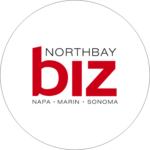
Jean Doppenberg is a lifelong journalist and the author of three guidebooks to Wine Country.
View all posts



